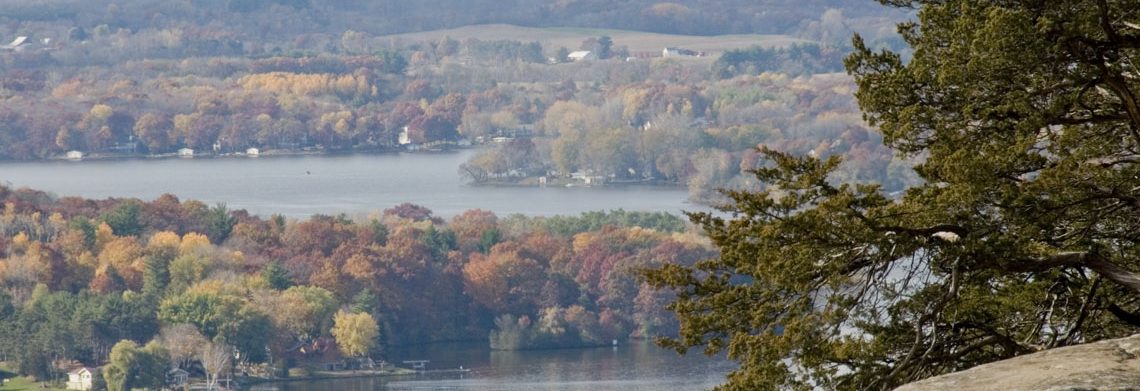Bracken Grassland
Counties:Florence, Marinette, Vilas |
|
Description:
Wisconsin bracken grassland is a type of natural community characterized by the presence of bracken fern (Pteridium aquilinum), Pennsylvania sedge (Carex pensylvanica), and Kalm’s brome grass (Bromus kalmii).
In addition to bracken fern, other common plant species found in Wisconsin bracken grasslands include grasses such as little bluestem (Schizachyrium scoparium) and panic grasses (Panicum spp.), as well as a variety of forbs, including goldenrod (Solidago spp.), milkweeds (Asclepias spp.), and asters (Symphyotrichum spp.).
This natural community is typically found on dry, well-drained soils and in areas with low nutrient levels, such as rocky outcrops and gravelly slopes. It is often found in areas that have been disturbed by human activity, such as abandoned fields, pastures, and roadsides.
Bracken grasslands integrate with pine barrens or northern dry forest, with jack pine (Pinus banksiana) as the dominant tree species. This community can be composed mostly of herbs and shrubs (with patches of ericaceous shrubs or occur as a complex mosaic of grassy or shrubby openings, interspersed with patches of jack pine, balsam fir (Abies balsamea), northern pin oak (Quercus ellipsoidalis), aspen, and cherry.
Other common herbs include poverty-oat grass (Danthonia spicata), Lindley’s aster (Symphyotrichum ciliolatum), gray goldenrod (Solidago nemoralis), and common strawberry (Fragaria virginiana). Some sites have variable coverages of low shrubs such as blueberries (Vaccinium angustifolium and V. myrtilloides), sweet fern (Comptonia peregrina), prairie willow (Salix humilis), and hazelnuts (Corylus spp.).
Bracken grasslands stand out from surrounding forests owing to frequent disturbance. Historic factors that likely influenced the growth of bracken grasslands include logging and associated high intensity wildfire.
This is a fire-dependent community maintained by relatively frequent ground fires. Other factors include occasional growing season frost damage and the allopathic effects of bracken ferns, field pussy-toes, and several hawkweed species that are a major component these grasslands. Bracken grasslands share some similarities with dry sand prairie, but because of its northerly range possesses fewer prairie species.
Typical landforms supporting Bracken Grassland are all the product of past glaciation, and these include pitted (collapsed) outwash, end moraine, and till plain. Soils are melanized sands, sandy loams, and loamy sands. Almost all of the occurrences are within the Northeast Sands, Northern Highland, and Northwest Sands ecological landscapes.
Wisconsin bracken grasslands plant communities provide important habitat for a variety of wildlife species, including birds, insects, and small mammals. They are vulnerable to a number of threats, including development, habitat fragmentation, and the introduction of invasive plant species. Conservation efforts to protect and restore these important natural communities are ongoing.
Based on the Wisconsin DNR Detailed Community Description.
Alternative Natural Community Names:
| Hoffman | Bracken Grassland |
| WI DNR | Bracken Grassland |
| US National Vegetation Classification |
Typical Plant Species:
[wip_curtiscom_lst_vw filter=”attr::emd_wip_eco_comcurtis::is::bracken-grassland;”]
Typical Animal Species:
[wip_ani_curtiscom_lst_vw filter=”attr::emd_ani_natcom::is::bracken-grassland;”]
References:
Curtis, John T. The Vegetation of Wisconsin. University of Wisconsin Press. 1959.
Epstein, E.E. Natural communities, aquatic features, and selected habitats of Wisconsin. Chapter 7 in The ecological land- scapes of Wisconsin: An assessment of ecological resources and a guide to planning sustainable management. Wisconsin Department of Natural Resources, PUB-SS-1131H 2017, Madison.
Hoffman, Randolph M. Wisconsin’s Natural Communities: How to Recognize Them, Where to Find Them, second edition. University of Wisconsin Press. 2002.
Wisconsin Department of Natural Resources. Wisconsin Wetland Inventory Classification Guide. 1992.
